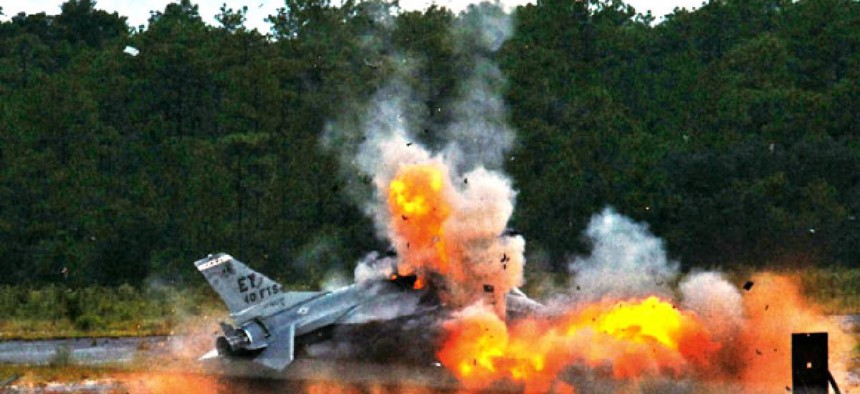Air Force seeks smart concrete for explosives testing

An Air Force explosion test was conducted on an F-16 Fighting Falcon in 2010. United States Air Force
‘Ultra-high performance concrete’ generates increasing buzz.
The Air Force wants smart concrete to build impact-resistant, fortress-like structures for explosives testing.
The service is soliciting ideas on how to build ultra-high performance concrete -- an industry term for exceptionally resilient concrete -- to “ground test against realistic targets at our test centers,” a Defense Department tender indicates.
UHPC, concrete mixed with quartz, bonding agents and nanostructures, has been used to fortify bunkers and bridges.
Engineers in Iran, an earthquake zone, are considered particularly adept at making UHPC. Their skill has stirred concerns that the concrete could be used to protect hidden nuclear installations.
In the first phase of this small business funding project, the Air Force wants to build test objects with strengths in excess of 30,000 pounds per square inch -- a unit used to measure how much pressure a structure can withstand. That’s at least six times more resilient than typical residential and light commercial buildings, which are built with concrete strengths between 2500 psi to 5000 psi, industry groups estimate.
The Air Force eventually wants funded researchers to scale up manufacturing processes. It envisions full-scale test structures with sizes of 22 by 22 by 4 feet being built in the final phase, the tender notes. Defense will start accepting proposals on August 27. The solicitation closes on September 6.
There has been growing buzz around UHPC in recent years in government circles. The Homeland Security Department, along with the U.S. Army Corps of Engineers research and development command, held talks with agencies and research labs last year to promote efforts to push out UHPC in the mass market and domestic infrastructure. “Adoption of UHPC in the U.S. has been slow in comparison to Europe and Asia, notably Australia, China, France, Germany, Iran, and Japan,” according to a DHS report.
The drive to make smarter and stronger concrete could very well be a zero-sum game on the battlefield, however. The very technology developed to help the U.S. gain an edge could make it harder for it to attack enemies. “While the Air Force is interested in UHPC for buildings, command centers, and runways, the role that UHPC might play in protecting potential adversaries and their installations must also be considered,” the Defense tender notes.





